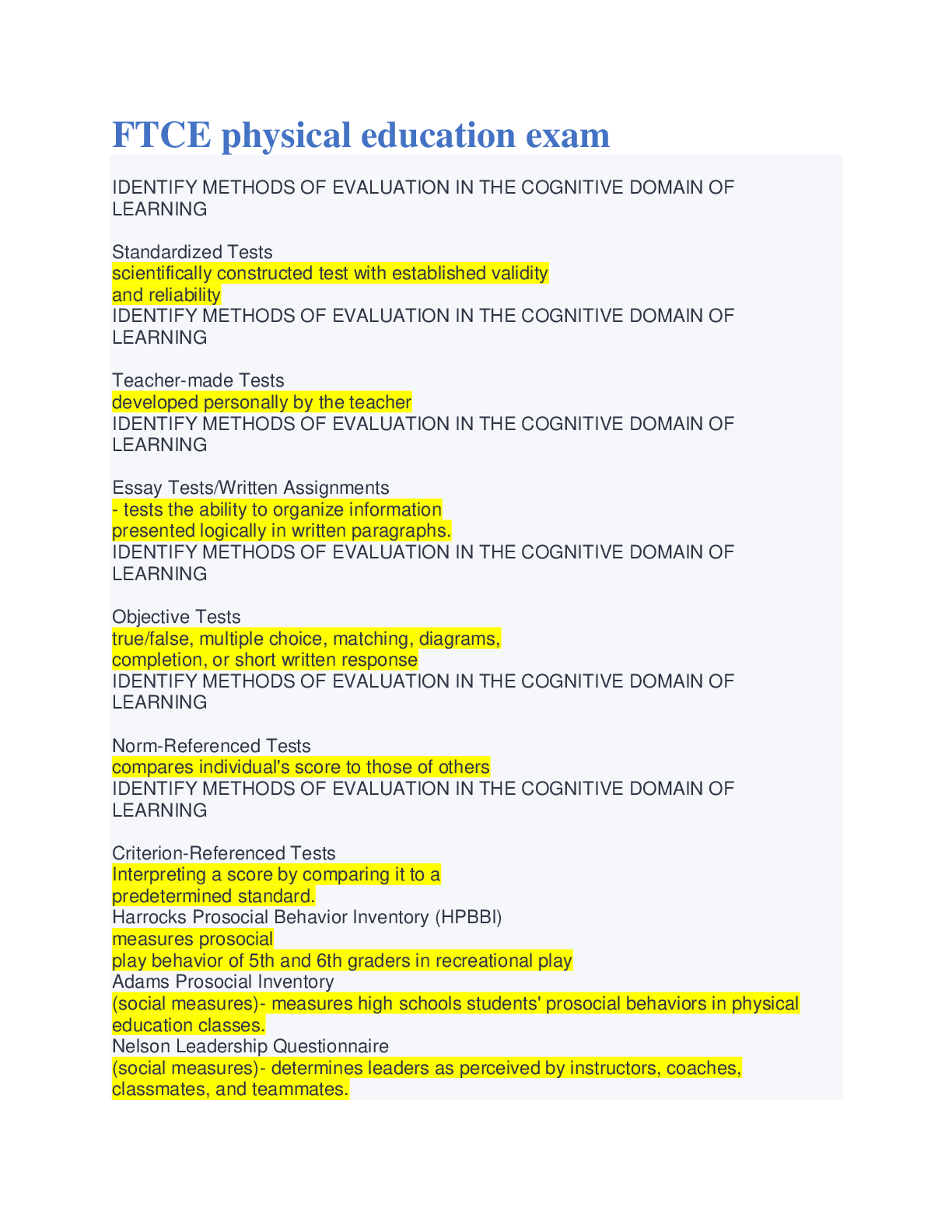Health Care > EXAM > CMS Practice Questions and answers 100% correct( reviewed) (All)
CMS Practice Questions and answers 100% correct( reviewed)
Document Content and Description Below
CMS Practice Questions A nurse is caring for a group of infants with congenital heart defects. For which of the following defects should the nurse expect to observe cyanosis? A. Transposition of... the great arteries B. Ventricular Septal Defect C. Coarctation of the Aorta D. Patent Ductus Ateriosus Correct Answer: A. Transposition of the great arteries An infant who has transposition of the great arteries will have severe cyanosis because reversal of the anatomical position of the aorta and pulmonary artery allows venous blood to enter the systemic circulation without oxygenation. A nurse is reviewing the laboratory results of a child who has experienced diarrhea for the past 24 hr. Which of the following values for urine specific gravity should the nurse expect? A. 1.010 B. 1.035 C. 1.020 D. 1.005 Correct Answer: 1.035 is a concentrated specific gravity, which is an expected value for a child who is dehydrated; therefore, this is an expected urine specific gravity for a child who has experienced diarrhea for 24 hours. Incorrect Answers: A. 1.010 is within the expected reference range for urine specific gravity. C. 1.020 is within the expected reference range for urine specific gravity. D. 1.005 is decreased urine specific gravity, which could indicate excessive fluid intake rather than dehydration. A nurse is teaching the guardian of a preschooler. The guardian states that the preschooler has had an imaginary playmate for about 3 months. Which of the following pieces of information should the nurse give the guardian? A. Children commonly begin having imaginary friends when they reach school age. B. Notify your provider if the imaginary friend persists longer than 6 months. C. Have your child take responsibility for actions I the tries to blame the imaginary friend. D. Set limits by not allowing your child to have the imaginary friend present during family meals. Correct Answer: Correct Answer: C. "Have your child take responsibility for actions if he tries to blame the imaginary friend." The nurse should inform the guardian that imaginary playmates are common during the preschool years due to the high level of imagination among this age group. Although having an imaginary friend is considered healthy, the preschooler might try to use this imaginary friend as a means of avoiding responsibility or punishment for unacceptable behavior. The nurse should inform the guardian of the need to have the preschooler take responsibility for his actions. Incorrect Answers:A. Imaginary playmates are common during the preschool years due to the high level of imagination among this age group.B. Imaginary playmates are common during the preschool years and are not a cause for concern as long as the preschooler also socialized with other children.DO. The nurse should instruct the guardian that this behavior is expected and that pretending with the preschooler is okay. A nurse is caring for a school-aged child who has sickle cell anemia. Which of the following actions should the nurse plan to take to help decrease THE RISK of a vast-occlusive crisis? A. Provide adequate fluid intake throughout the day B. Provide oxygen at 2 L/min via nasal cannula C. Administer a blood transfusion D. Give ibuprofen to manage pain Correct Answer: A. Provide adequate fluid intake throughout the day Adequate hydration is an effective strategy to help prevent sickle cell crisis. Maintaining adequate hydration can reduce the risk of sickle cell formation. Incorrect Answers:B. Oxygen might be necessary to manage a sickle cell crisis, but it is not routinely used to prevent a crisis.C. A blood transfusion might be necessary to manage a sickle cell crisis, but it is not routinely used to prevent a crisis.D. The nurse can administer ibuprofen to manage the pain of a sickle cell crisis, but this measure will not prevent a crisis from occurring. A nurse is taking the history of and performing a physical on a school-age child who has attention deficit hyperactivity disorder (ADHD). Which of the following findings in the child's medical record should the nurse identify as a risk factor for ADHD? A. The child's family has a middle-class socioeconomic background. B. The child had prenatal exposure to alcohol on a regular basis. C. Both siblings of the child show moderate activity levels in school and play activities. D. The child's mother currently has diabetes mellitus. Correct Answer: B. The child had prenatal exposure to alcohol on a regular basis. Prenatal exposure to alcohol on a regular basis is a contributing factor to ADHD, along with prenatal nicotine exposure and exposure to lead or mercury. Incorrect Answers:A. The child's socioeconomic background is not likely to cause ADHD. Risk factors include prenatal alcohol exposure, lead exposure, genetic factors, and traumatic brain injury.C. Sibling activity level is not likely to cause ADHD.D. There is no indication that a current illness of the child's mother is a risk factor for ADHD. A nurse is caring for a 4-year-old child who has pneumonia. The child's mother left 2 hours ago, and he is currently experiencing the separation anxiety stage of despair. Which of the following findings should the nurse expect? A. Crying and screaming B. Inactivity and thumb sucking C. Showing interest in nearby toys D. Attempting to escape and find the parent Correct Answer: B. Inactivity and thumb sucking A child who is sucking his thumb and refusing to eat or drink is displaying manifestations of the second stage of separation anxiety, which is despair. Incorrect Answers: A. Protest is the first stage of separation anxiety, which includes crying and screaming. C. Denial or detachment is the third stage of separation anxiety, in which the child appears happy and interacts with strangers. D. Protest is the first stage of separation anxiety, which includes attempting to escape the area to find a parent. A nurse in a pediatric clinic is caring for a 3-year-old child who has a blood lead level of 3 mcg/dL. When teaching the toddler's parent about the correlation of nutrition with lead poisoning, which of the following pieces of information is appropriate for the nurse to include? A. Decrease the child's vitamin C intake until the blood lead level decreases to zero B. Administer a folic acid supplement to the child each day C. Give pancreatic enzymes to the child with meals and snacks D. Ensure the child's dietary intake of calcium and iron is adequate Check Answer Correct Answer: D. Ensure the child's dietary intake of calcium and iron is adequate A child who has an elevated blood lead level should have an adequate intake of calcium and iron to reduce the absorption of and effects from the lead. Dietary recommendations should include milk as a good source of calcium. Incorrect Answers: A. Vitamin C does not influence absorption or excretion of lead, and intake does not need to be reduced for a child who has a blood lead level of 3 mcg/dL. Over time, a reduced intake can result in a vitamin C deficiency. B. A 3-year-old child does not need a folic acid supplement. This will not influence absorption or excretion of lead. C. Pancreatic enzymes are administered to children who have cystic fibrosis, not an elevated blood lead level. A nurse is caring for an adolescent who has sickle cell anemia. Which of the following manifestations is/are the result of chronic vaso-occlusive phenomena? (Select all that apply.) A. Enlarged heart [Show More]
Last updated: 2 years ago
Preview 1 out of 19 pages

Buy this document to get the full access instantly
Instant Download Access after purchase
Buy NowInstant download
We Accept:

Reviews( 0 )
$15.00
Can't find what you want? Try our AI powered Search
Document information
Connected school, study & course
About the document
Uploaded On
Jul 09, 2022
Number of pages
19
Written in
Additional information
This document has been written for:
Uploaded
Jul 09, 2022
Downloads
0
Views
95


























